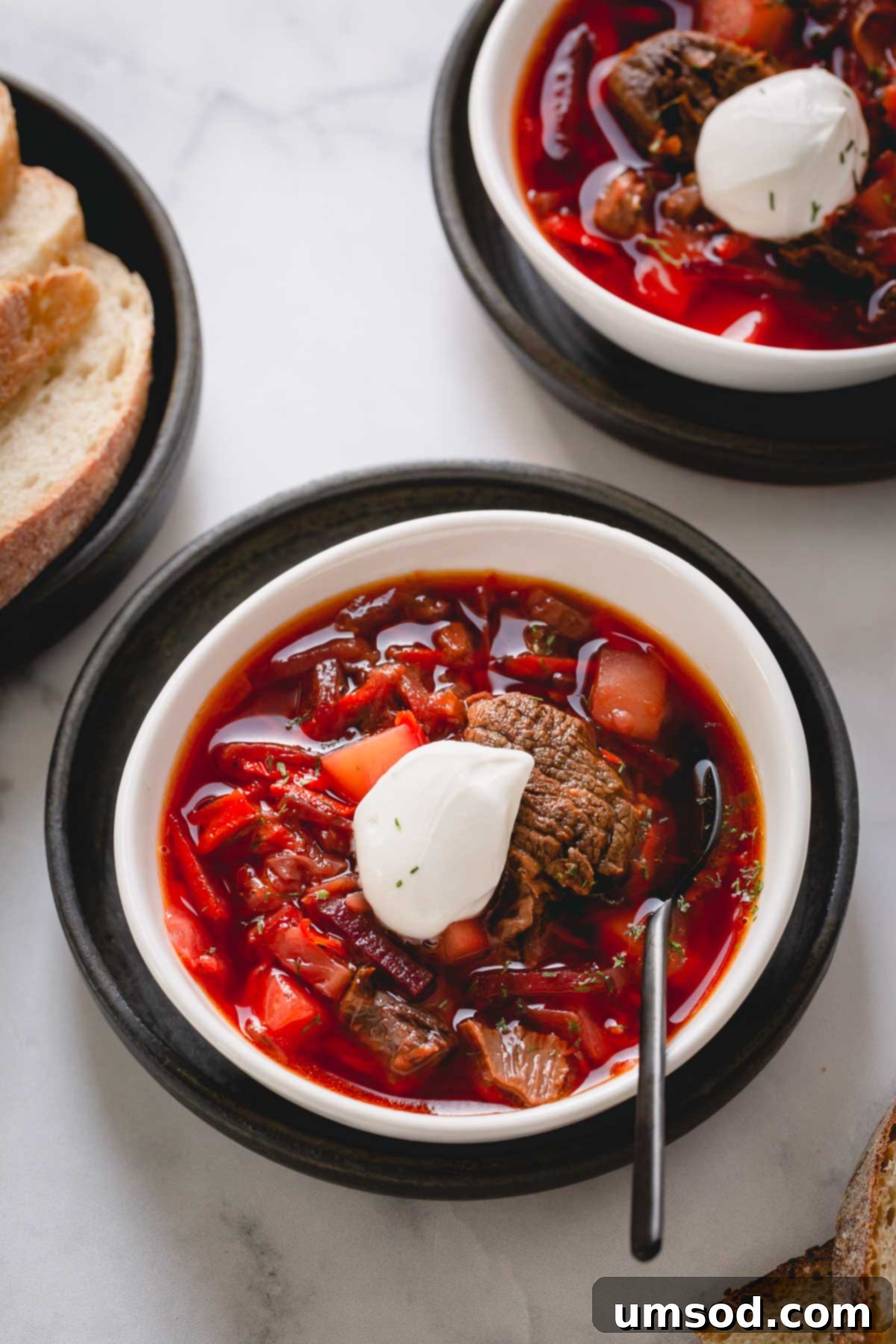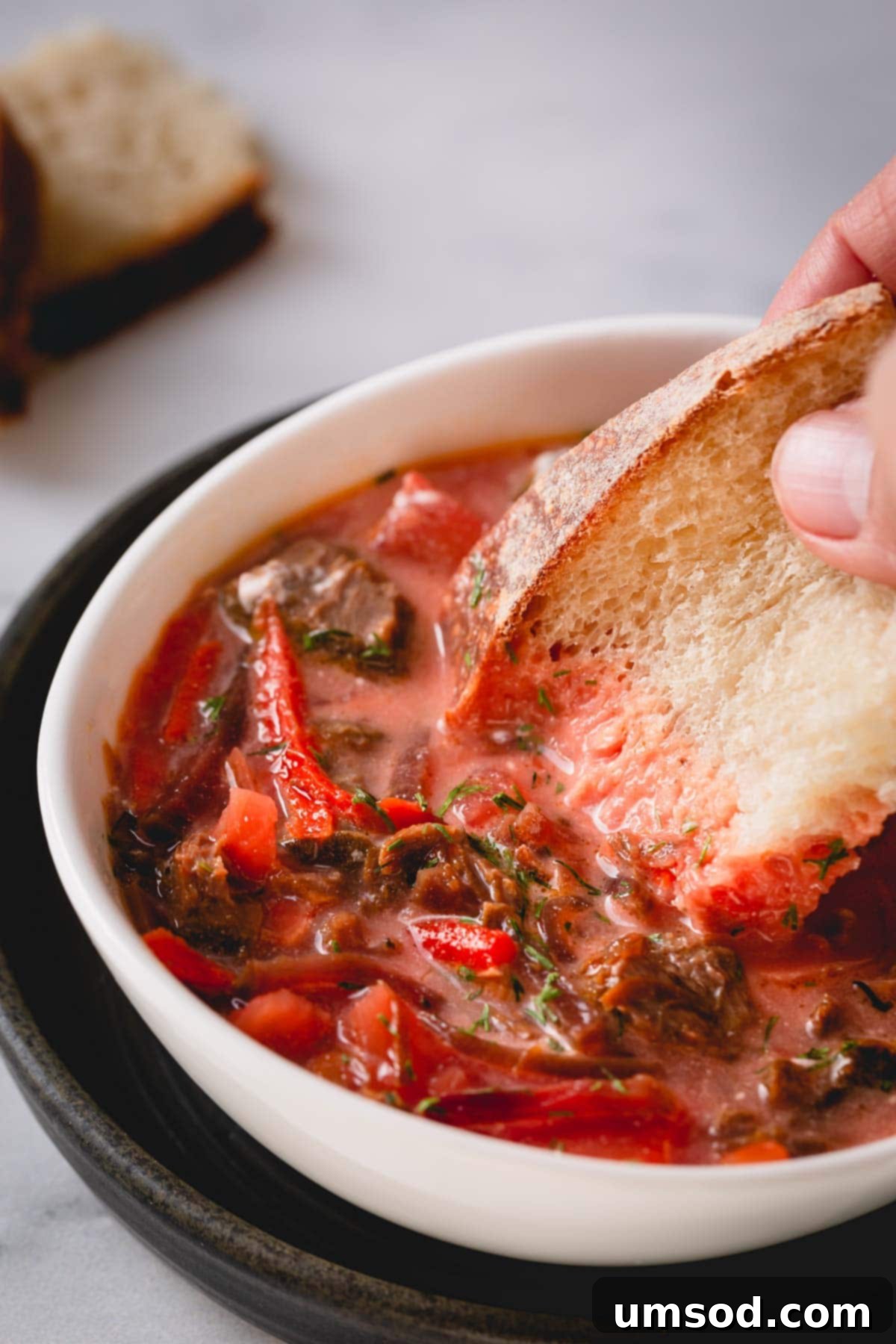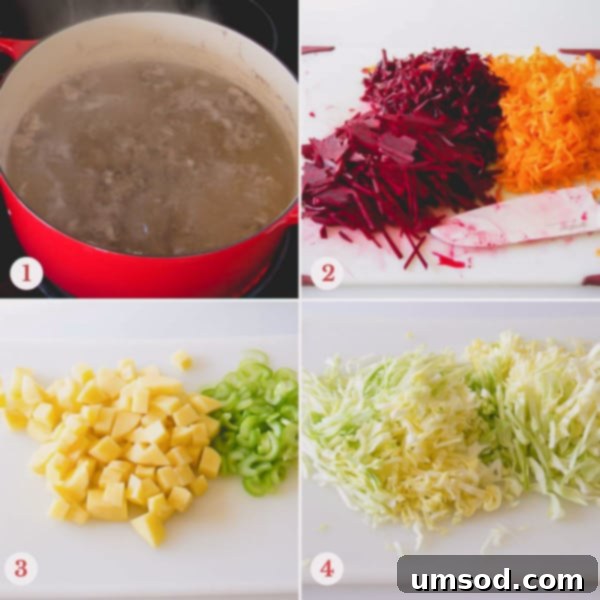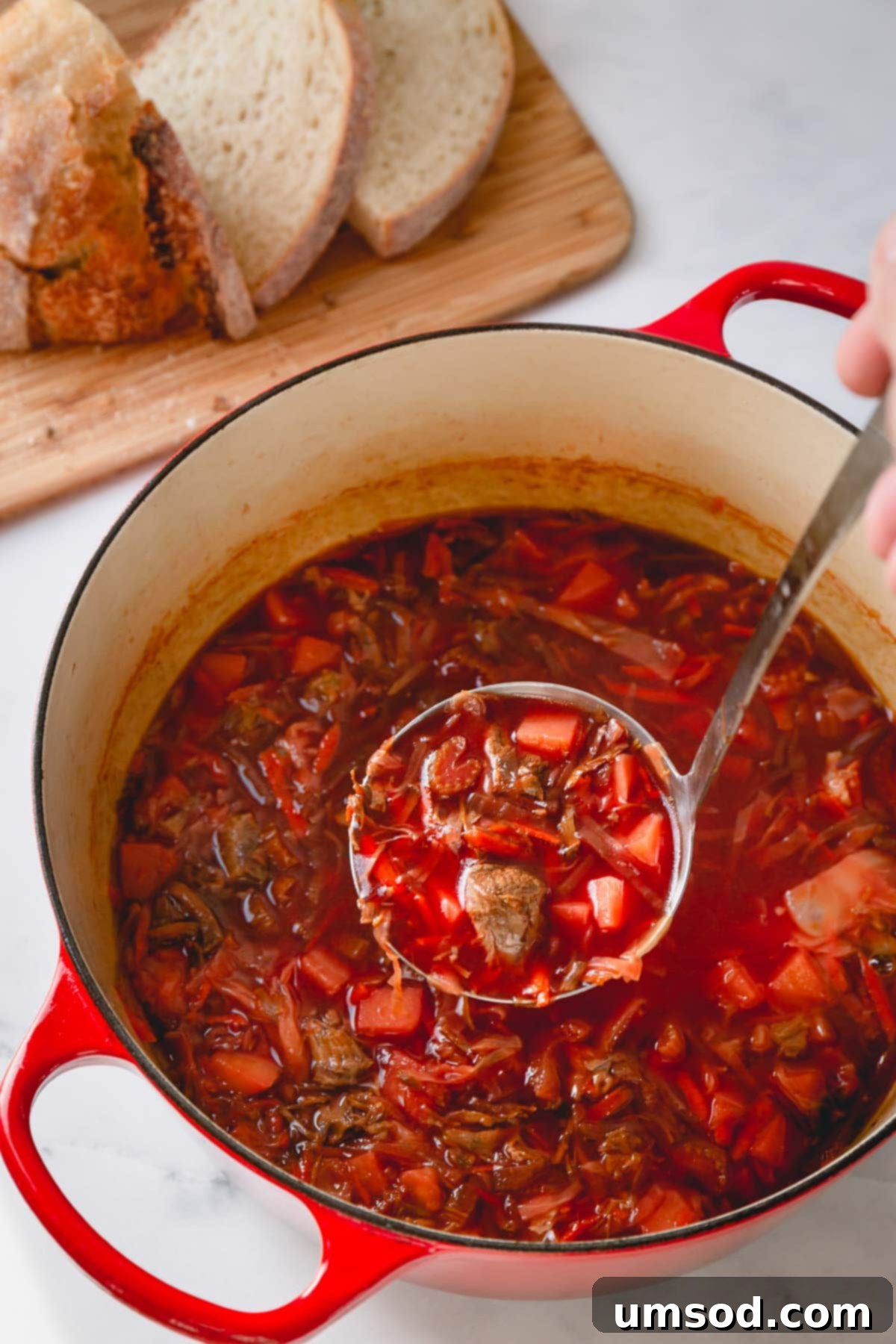Nothing truly compares to the comforting embrace of a warm bowl of wholesome borscht soup on a chilly winter day. This classic beef borscht recipe offers a harmonious blend of simple, fresh ingredients, a time-honored cooking method, and an authentic taste that will transport you straight to the heart of Eastern Europe. It’s more than just a soup; it’s a culinary experience, rich in flavor, history, and vibrant color.

This beautiful, deep red beet soup holds a special place in my heart, evoking cherished childhood memories. While I may not be ethnically Russian, I wholeheartedly consider myself Russian at heart. My formative years, from the age of three, were spent immersed in a vibrant Russian community, where I learned to speak, read, and write in Russian. This deep cultural connection has given me a unique perspective and appreciation for Russian cuisine, particularly beloved dishes like borscht.
Indeed, I’ve had the pleasure of exploring many facets of Eastern European cooking. If you share my passion for these rich flavors, you might also enjoy my recipes for Russian Piroshki, savory Shashlyk, and delightful Lacy Crepes. But for now, let’s dive into the magnificent world of authentic beef borscht.
Why You’ll Absolutely Love This Authentic Beef Borscht Recipe:
Borscht, though widely recognized as a traditional Ukrainian dish, enjoys immense popularity across Russia, the former USSR countries, and even parts of Northern Asia. Its hearty nature and comforting flavors have made it a staple in countless households.
Interestingly, it’s also quite popular here in North Dakota, thanks to the Ukrainian immigrants who settled in the region many years ago, bringing their rich culinary traditions with them. This widespread appreciation highlights the soup’s universal appeal.
The beauty of borscht lies in its versatility. There isn’t just one “correct” way to make it; every family, and indeed every cook, brings their unique touch to the pot. This recipe, however, offers a robust and satisfying experience that you’ll adore for numerous reasons:
- Packed with Nutrient-Rich Vegetables: This borscht is generously loaded with an array of fresh, wholesome vegetables. The best part? Even picky eaters often fall in love with its vibrant flavors and satisfying texture, making it a fantastic way to boost vegetable intake.
- Incredibly Easy to Customize: Whether you prefer it with tender beef or a vegetarian twist, this recipe is highly adaptable. You can effortlessly adjust ingredients, replace vegetables based on what’s in season or your dietary preferences, ensuring a perfect pot every time.
- Ideal for Meal Prepping: This recipe yields a generous batch, making it perfect for preparing ahead. Borscht is one of those magical dishes that tastes even better the next day, as the flavors meld and deepen over time. It’s a convenient and delicious solution for busy weeknights.
And here’s a delightful secret: even those who claim to dislike beets often find themselves unexpectedly charmed by this soup’s complex and inviting profile!

Key Ingredients for the Perfect Beef Borscht:
Crafting an exquisite bowl of borscht begins with selecting the right ingredients. Each component plays a vital role in building the soup’s characteristic depth of flavor and vibrant appearance.
- Beef: While a great borscht can be made without meat, we believe beef adds an unparalleled richness and heartiness. For the most flavorful broth and tender meat, opt for a beef soup bone, chuck roast, stew meat, or top sirloin. These cuts break down beautifully during the simmering process, infusing the soup with robust flavor.
- Beets: These crimson gems are truly the star of the show, giving borscht its iconic deep red hue and earthy sweetness. I recommend preparing them in two ways: grate half of the beets on a large box grater for a smoother texture that melts into the broth, and cut the other half into matchsticks with a knife to provide a delightful textural variation in every spoonful.
- Carrots: Another foundational vegetable, carrots contribute natural sweetness and a beautiful orange counterpoint to the beets. Like beets, I prefer to grate them on a large box grater for even cooking and distribution. Feel free to use classic orange carrots or experiment with rainbow varieties for a visually appealing touch.
- Onion and Garlic: These aromatic powerhouses lay the groundwork for rich flavor. They are sautéed to release their fragrant oils, creating a savory base. In my kitchen, I often omit onion due to my husband’s dietary restrictions, but if you can include it, it adds a layer of sweet pungency that truly elevates the soup.
- Tomato Paste: This concentrated ingredient is absolutely crucial for building a deep, umami-rich flavor profile. Its acidity also helps balance the sweetness of the beets and carrots. Some traditional recipes might use a touch of ketchup, but tomato paste offers a more intense and authentic depth.
- Celery: While not a traditional vegetable in classic Ukrainian borscht, I find celery to be a wonderful addition. It brings a subtle freshness and a pleasant crunch that complements the other root vegetables. However, if you prefer to stick to the most traditional interpretation, feel free to omit it.
- Potatoes: Essential for making the soup substantial and satisfying, potatoes absorb the flavors of the broth beautifully. I like to cut them into small, uniform cubes. This ensures they cook faster and makes them easy for everyone, especially little ones, to enjoy.
- Cabbage: A generous amount of cabbage adds bulk, a pleasant textural contrast, and a slightly sweet, mild flavor. You can use any variety: green, purple, or even Napa cabbage. While Napa cabbage isn’t traditionally used, I appreciate its quicker cooking time and delicate texture, which integrates seamlessly into the soup.
- Bay Leaf, Lemon Juice, Dill (or Parsley): These are the finishing touches that elevate the borscht from good to extraordinary. Bay leaf adds an aromatic depth during cooking, while a squeeze of fresh lemon juice at the end brightens the flavors and helps preserve the beets’ vibrant color. Fresh dill or parsley sprinkled over the top provides a burst of freshness and an authentic Eastern European aroma.
Tip: Crafting a Delicious Vegetarian Borscht
To effortlessly transform this hearty beef borscht into a delightful vegetarian version, simply substitute the beef with your favorite plant-based proteins. Hearty beans, such as kidney beans or cannellini beans, and an assortment of fresh or dried mushrooms make excellent additions, providing both texture and umami depth. Remember to use a rich vegetable broth as your base instead of beef broth to maintain a fully meat-free dish.
How to Make Classic Beef Borscht: A Step-by-Step Guide
Making borscht is a labor of love, but it’s a process that yields incredibly rewarding results. Follow these steps for a perfectly balanced and flavorful soup.
1. Make Beef Broth and Prepare Vegetables
Our journey to the perfect borscht begins with a rich, flavorful beef broth. If you’re fortunate enough to have beef on the bone, that’s fantastic! Start by simmering the bone-in beef in cold water. Once cooked, remove the beef, allow it to cool slightly, and then cut the tender meat into small, bite-sized pieces. If you’re using boneless beef, go ahead and cut the meat into 1-inch cubes before making the broth. As the broth comes to a boil, you’ll notice some foamy scum rising to the surface. It’s important to remove this with a slotted spoon right away; this step, while primarily for aesthetic reasons to ensure a clear broth, also helps in achieving a cleaner flavor.
While your beef broth is gently simmering, take this time to thoroughly wash, peel, and meticulously cut all your vegetables. This mise en place is crucial for a smooth cooking process and ensures everything is ready when needed.
Tip: Handling Beet Stains with Ease
Don’t fret about using disposable gloves when handling vibrant beets. If you promptly wash your cutting board and hands with soap immediately after chopping and working with beets, the crimson stain won’t linger. Any residual pink will completely disappear after just a couple of washes, leaving your hands and surfaces clean.

2. Mastering the Zajarka (Sautéed Vegetable Base)
The “zajarka” (or “mirepoix”) is a fundamental component of borscht, a flavorful sautéed vegetable mixture that forms the soul of the soup. In a large skillet (a 12-inch skillet works perfectly for this), heat a tablespoon of olive oil over medium-low heat. Add your finely minced onion (if using), garlic, and grated carrots. Sauté these aromatics until they become beautifully fragrant and slightly softened, which typically takes about 2 minutes. This step is crucial for developing the foundational flavors.
Next, stir in the prepared beets – both grated and matchstick forms – followed by the tomato paste. Continue to cook this vibrant mixture for approximately 8 minutes, stirring frequently. This allows the tomato paste to caramelize slightly, deepening its flavor, and the beets to begin releasing their beautiful color and earthy sweetness into the oil, creating a rich, savory, and intensely colored base for your soup.

If you find yourself pressed for time and need a quicker alternative, you might enjoy my simple borscht recipe, which offers a streamlined approach without sacrificing flavor.
3. Assembling and Simmering the Soup
With your rich beef broth simmering and the aromatic zajarka ready, it’s time to bring all the components together. To your simmering broth, add the cubed potatoes, sliced celery (if using), thinly sliced cabbage, and a bay leaf. Continue to cook the soup, allowing these vegetables to soften until the potatoes are tender when pierced with a fork. This ensures all the vegetables are perfectly cooked and integrated into the soup’s texture.
Once the potatoes have reached their tender perfection, reduce the heat to medium-low. Gently stir in the prepared carrot and beet mixture (zajarka), along with a generous squeeze of fresh lemon juice. The lemon juice is not just for flavor; it also helps to preserve the vibrant, beautiful red color of the beets, preventing it from fading during cooking. Finally, add your choice of fresh dill or parsley and a generous amount of freshly ground black pepper. Allow the soup to gently simmer for another 5 minutes, giving all the flavors a chance to meld beautifully and create that authentic borscht taste.

What to Serve with Borscht: Traditional Accompaniments
Borscht is a complete meal in itself, but it truly shines when paired with traditional accompaniments. In Eastern European culture, borscht is most commonly served with a generous dollop of cool, creamy sour cream and a slice of hearty, fresh bread – and that’s precisely how I enjoy it the most! The tang of the sour cream beautifully balances the earthy sweetness of the beets. For an extra flourish, feel free to garnish your bowl with more fresh dill or parsley, adding an aromatic burst and vibrant green contrast.
Beyond these staples, consider serving your borscht with a side of pampushky (Ukrainin garlic bread rolls) for an authentic touch, or a simple green salad dressed with a light vinaigrette to complement the rich flavors. A small dish of minced raw garlic on the side for those who enjoy an extra kick is also a popular option.
Storing and Reheating Your Borscht for Maximum Flavor
One of the many wonders of beef borscht is how well it stores. In fact, like many stews and hearty soups, it often tastes even better the next day, as the ingredients have more time to mingle and deepen in flavor. It’s an ideal candidate for meal prepping!
After enjoying your initial serving, I typically divide any leftover soup into airtight plastic soup containers for easy storage and portioning.
- Refrigeration: Leftover borscht can be safely stored in the refrigerator for up to 5 days. Ensure it cools completely before transferring to containers.
- Freezing: For longer storage, borscht freezes exceptionally well. You can freeze it for up to 3 months. Thaw overnight in the refrigerator before reheating.
To reheat, simply scoop out the desired amount into a saucepan and gently simmer on the stovetop over low to medium heat until it’s heated through, stirring occasionally. Alternatively, you can microwave individual portions for about 2 minutes, stirring halfway through, until piping hot.
Tip: Preserving Borscht’s Vibrant Color
To maintain the beet soup’s signature bright red color, avoid repeated vigorous boiling or extended simmering during reheating. Gentle heating is key to preserving its beautiful hue and ensuring it looks as appealing as it tastes.


Classic Beef Borscht
Shinee Davaakhuu
15 minutes
45 minutes
1 hour
8
servings
Comment
Print Recipe
Ingredients
For beef broth:
-
1 lb
(450g) beef
cut into 1-inch cubes Note 1 -
2 teaspoons
coarse kosher salt
divided
For zajarka/mirepoix:
-
1 tablespoon
olive oil -
2
garlic cloves
pressed -
1
medium yellow onion -
2
medium carrots -
2
medium beets -
4 tablespoons
tomato paste
Note 2
For soup:
-
2
medium potatoes
Yukon gold or russet -
2
celery ribs
optional -
1/4
cabbage
2-3 cups chopped Note 3 -
1
bay leaf -
¼ cup
parsley or dill
chopped - Juice of half a lemon
- Sour cream and bread for serving
Instructions
To make beef broth:
- In a large pot (I use a 5qt Dutch oven), add beef chunks, 10 cups of cold water, and 1 tablespoon of salt. Bring it to a boil over medium-high heat. As it boils, skim off any foam or scum that rises to the surface for a clearer broth. Then, reduce the heat to medium and let it gently simmer for about 45 minutes until the beef is tender and the broth is flavorful.
To prepare vegetables:
- Meanwhile, thoroughly wash and peel all the vegetables.
Grate the carrots and one beet on a large box grater. Julienne the other beet using a knife for textural variation. (You can grate all or julienne all if preferred.) - Cube the potatoes into small pieces and slice the celery into thin pieces.
Thinly slice the cabbage.
Finely mince the onion.
To cook zajarka/mirepoix:
- Heat the olive oil in a large skillet (a 12-inch skillet is recommended) over medium-low heat.
- Add the minced onion, grated carrots, and pressed garlic to the skillet. Sauté until fragrant and slightly softened, about 2-3 minutes. Then, stir in the prepared beets and tomato paste and cook for 8 minutes, stirring frequently, allowing the flavors to deepen and meld.
To make the soup:
- Once the beef broth has been cooking for approximately 30 minutes and the beef is tender, add the cubed potatoes, sliced celery, shredded cabbage, and the bay leaf to the pot. Continue to cook the soup until the potatoes are tender when pierced with a fork, ensuring all vegetables are perfectly cooked.
- Once the potatoes are cooked through, reduce the heat to medium-low. Stir in the sautéed carrot and beet mixture (zajarka) along with the freshly squeezed lemon juice into the soup. The lemon juice will brighten the flavors and help maintain the beets’ vibrant color.
- Gently simmer the soup for another 5 minutes to allow all the flavors to fully meld. Finally, add freshly ground black pepper and the fresh parsley or dill. Taste and adjust seasoning if necessary.
- Serve immediately, garnished with a dollop of sour cream and a slice of crusty bread. Enjoy your authentic homemade beef borscht!
⭐️ Did you make this recipe?
Please leave a review and let us know how you liked it!
Tips & Notes
Note 2: Tomato Paste Importance Tomato paste is essential for adding a rich depth of flavor to the soup. Some recipes also use a small amount of ketchup for a slightly sweeter tang, but paste provides a more robust base.
Note 3: Cabbage Variety You have flexibility with the cabbage; green, purple, or even Napa cabbage can be used. While Napa cabbage is less traditional, its quick cooking time and subtle texture are appealing.
Storing Tips:
Beef borscht stores exceptionally well and often tastes even better the day after. I recommend storing any leftover soup in airtight plastic soup containers.
– Refrigerate for up to 5 days.
– Freeze for up to 3 months for long-term enjoyment.
To reheat, simply warm the desired portion gently on the stovetop until heated through, or microwave for about 2 minutes. (TIP: Be mindful that repeated boiling or extended heating can cause the beet soup to lose its vibrant, bright color.)
Nutrition
171
kcal
17
g
15
g
5
g
5
g
713
mg
Soup
Russian

Did you make this?
Leave a rating and your feedback. Thank you!
This recipe was originally shared on February 23, 2016.
We hope this comprehensive guide inspires you to create a heartwarming and authentic pot of beef borscht in your own kitchen. This vibrant, flavorful soup is more than just a meal; it’s a taste of tradition, comfort, and culinary heritage. Enjoy the process of bringing this classic dish to life, and savor every delicious spoonful!
